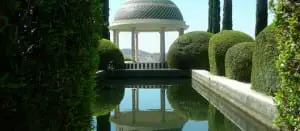
Surely many of you wonder since when gardening has been practiced, so today I will give you a brief account of its history. Apparently the first gardens appeared in the Egyptian cultureby 1500 BC, were characterized by the abundance of lotus flowers and pondsalthough they also had plants typical of their geographical area, such as palm trees.
However, the first gardens known to all, would be built many years later, around 600 BC, in persia. These gardens were built by the king Nebuchadnezzar and they constituted one of the seven wonders of the world. They are the famous Hanging Gardens of Babylon.
From Persia it spread to Greece, where it was given a more religious character with an abundance of statues. From here the art of gardening passed to Rome and then to Spain, where the Arabs after the XNUMXth century, turned the gardens into a representation of paradisewith numerous ponds and fountains surrounded by lush vegetation. A clear example is the gardens of the Alhambra of Granada.
At the same time that the Arabs made lush gardens, in China and Japan minimalist gardens appeared, the well-known Zen gardenswhere what is sought is to contemplate the natural elements.
Later, during the Renaissance period, they began to appear, especially in France. boxwood and myrtle gardens pruned to obtain geometric shapes. Of this style are the gardens of Versailles.
In the XNUMXth century, the first public garden in Spain was built, the Alameda de Hércules in Seville.
Then, two centuries later, romanticism appeared and with it the English garden with which it was tried to recreate nature itself, with very natural gardens where irregular meadows were mixed with flower beds and winding paths.
Finally, in the last century, the urban garden appeared to remedy the lack of green spaces in cities.
With this first article that welcomes me to JarderíaON, I hope to help you learn more about the beginnings of gardening.
More information – Learn how to design a Japanese garden

